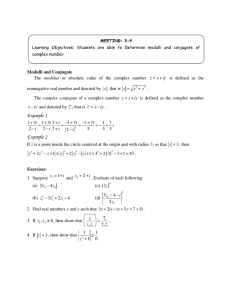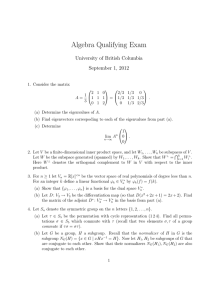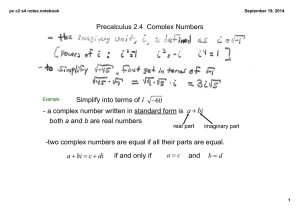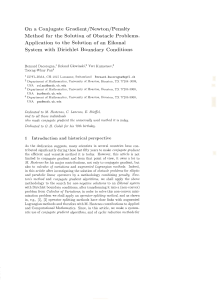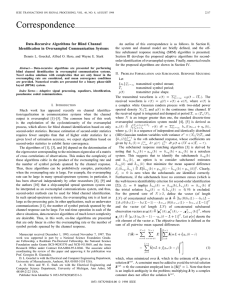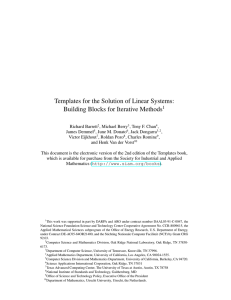Administrivia: November 9, 2009
advertisement
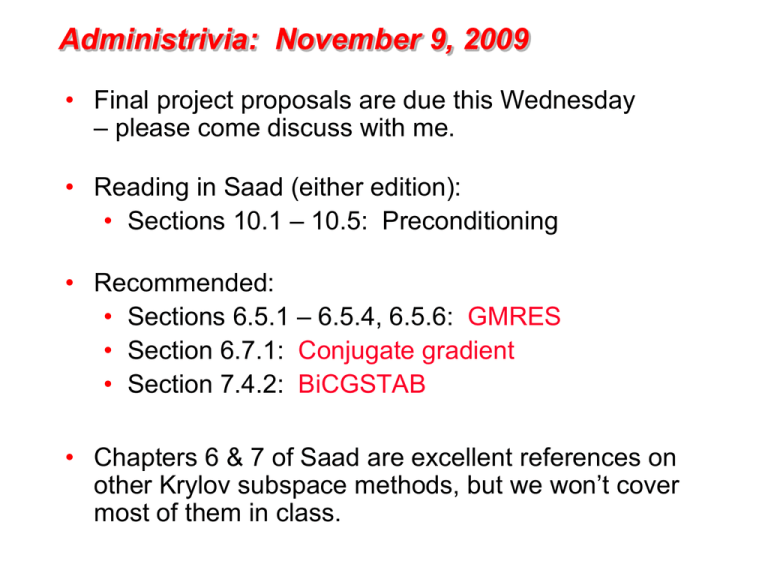
Administrivia: November 9, 2009 • Final project proposals are due this Wednesday – please come discuss with me. • Reading in Saad (either edition): • Sections 10.1 – 10.5: Preconditioning • Recommended: • Sections 6.5.1 – 6.5.4, 6.5.6: GMRES • Section 6.7.1: Conjugate gradient • Section 7.4.2: BiCGSTAB • Chapters 6 & 7 of Saad are excellent references on other Krylov subspace methods, but we won’t cover most of them in class. Conjugate gradient iteration x0 = 0, r0 = b, d0 = r0 for k = 1, 2, 3, . . . αk = (rTk-1rk-1) / (dTk-1Adk-1) xk = xk-1 + αk dk-1 rk = rk-1 – αk Adk-1 βk = (rTk rk) / (rTk-1rk-1) dk = rk + βk dk-1 step length approx solution residual improvement search direction • One matrix-vector multiplication per iteration • Two vector dot products per iteration • Four n-vectors of working storage Conjugate gradient: Orthogonal sequences • Krylov subspace: Ki (A, b) = span (b, Ab, A2b, . . ., Ai-1b) • Conjugate gradient algorithm: for i = 1, 2, 3, . . . find xi Ki (A, b) such that ri = (b – Axi) Ki (A, b) • Notice ri Ki+1 (A, b), so ri rj for all j < i • Similarly, the “directions” are A-orthogonal: (xi – xi-1 )T·A· (xj – xj-1 ) = 0 • The magic: Short recurrences. . . A is symmetric => can get next residual and direction from the previous one, without saving them all. Conjugate gradient: Convergence • In exact arithmetic, CG converges in n steps (completely unrealistic!!) • Accuracy after k steps of CG is related to: • consider polynomials of degree k that are equal to 1 at 0. • how small can such a polynomial be at all the eigenvalues of A? • Thus, eigenvalues close together are good. • Condition number: κ(A) = ||A||2 ||A-1||2 = λmax(A) / λmin(A) • Residual is reduced by a constant factor by O(κ1/2(A)) iterations of CG. Complexity of linear solvers Time to solve model problem (Poisson’s equation) on regular mesh n1/2 n1/3 2D 3D Dense Cholesky: O(n3 ) O(n3 ) Sparse Cholesky: O(n1.5 ) O(n2 ) CG, exact arithmetic: O(n2 ) O(n2 ) CG, no precond: O(n1.5 ) O(n1.33 ) CG, modified IC0: O(n1.25 ) O(n1.17 ) CG, support trees: Multigrid: O(n1.20 ) -> O(n1+ ) O(n1.75 ) -> O(n1.31 ) O(n) O(n)

